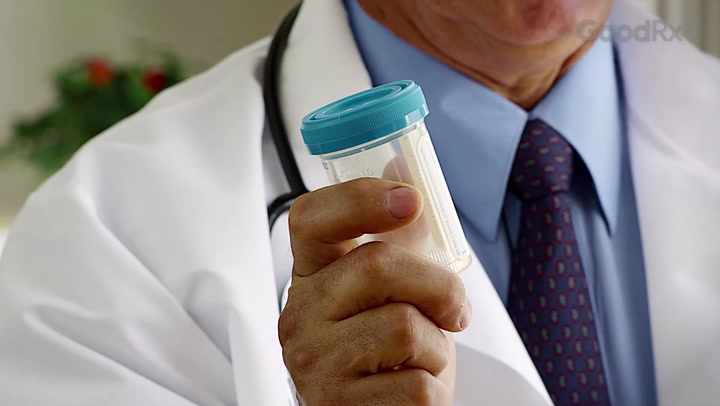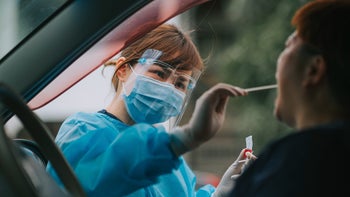
Creatinine Blood Test: What It Means If Your Level Is High or Low
Key takeaways:
The creatinine blood test is an indirect marker for kidney function. High levels can sometimes indicate a problem with the kidneys.
A high creatinine level doesn’t necessarily mean you have kidney problems. Your hydration status, muscle mass, and even recent heavy exercise can affect your blood test results.
There’s no special preparation you need to do before a creatinine blood test. But it’s a good idea to make sure you’re well hydrated beforehand.
Table of contents

Creatinine is one of the most common blood tests. It’s usually measured as part of your routine bloodwork. And it’s mainly used as a way to measure your kidney function. So what does it mean if your level is high or low? Here’s how to understand your creatinine test results and what to do if they’re out of range.
What is creatinine on a blood test?
Creatinine is a waste product. It’s created when your body breaks down protein. That could be dietary protein (from foods you eat) or protein inside your muscles (which gets broken down on a regular basis).
Creatinine builds up in your blood and then gets filtered out by your kidneys. Your kidneys then get it out of your body through urine. Since a creatinine blood test measures the amount of creatinine in your blood at a moment in time, it provides a rough estimate of how your kidneys are filtering out waste.
Save over 40% on Qsymia with GoodRx
Discover the once daily Qsymia for weight management. Qsymia is for adults and children 12-17 in combination with a healthy diet and regular exercise.

Creatinine levels can naturally vary from person to person (and day to day), even among people with normal kidney function. This is based on things like:
Diet
Muscle mass
Current hydration status
Recent exercise
Medications and supplements
It’s important to note that creatinine isn’t the same as creatine. Creatine is a protein-like compound that can be found in many foods and supplements. It’s also a normal component of healthy muscles and brain tissue.
What is a normal creatinine range?
Everyone will always have at least some creatinine in their blood. This is because the body is always in the process of creating and removing waste. So a “normal” creatinine range is 0.5 mg/dL to 1.5 mg/dL.
But sometimes comparing your creatinine levels over time is more helpful than the absolute number. For example, if you previously had a creatinine level of 0.5 mg/dL, it might be concerning to suddenly have a jump to 1.5 mg/dL without any explanation.
What causes a high creatinine?
High creatinine can have many causes. And not all of them are related to changes in kidney function. These include:
Certain medications
Dehydration (which affects the kidneys, but it doesn’t cause long-term problems once it’s treated)
Increased muscle mass
Recent intense exercise
False alarm: High creatinine levels don’t always indicate a problem. Something in your medicine cabinet may be to blame instead. Learn more about medications that can cause a falsely high creatinine result.
Kidney protection: If you’re living with kidney disease, what you drink can potentially make a difference. Experts cover some of the best (and worst) drinks for your kidneys.
Damage control: Certain medications can increase the risk of kidney damage. Learn about 10 common prescription and over-the-counter culprits, and what to do if you suspect kidney problems from your medication.
But a high creatinine level can also reflect problems with the kidney, such as:
Kidney damage from medications (ibuprofen, naproxen, and some blood pressure medications are common culprits)
Diabetes
High blood pressure (hypertension)
Inflammation from autoimmune conditions
Blocked flow of urine due to a kidney stone or ureteral stone
Diabetes and high blood pressure are — by far — the most common causes of chronic kidney problems in the United States.
Read more like this
Explore these related articles, suggested for readers like you.
What should you do if you have high creatinine?
If your creatinine level is high, especially if it’s higher than previous levels, you should take the following steps:
Ask your healthcare team if you need additional testing for your kidney function. There are other tests that can assess kidney function. These include glomerular filtration rate (eGFR), blood urea nitrogen (BUN), cystatin C, and a urinalysis.
Stop taking ibuprofen, naproxen, or any other nonsteroidal anti-inflammatory drugs (NSAIDs).
Try to stay well hydrated, without overdoing it. Your urine should ideally be a clear light yellow color.
Check your blood pressure twice daily and record your results, to discuss with your healthcare team.
Check your blood sugar if you have or might have diabetes.
You should also monitor any symptoms of kidney problems. And get medical help immediately if you have:
A significant decrease in urination
Bloody or dark-colored urine
Confusion
New nausea or vomiting
Shortness of breath
When should you recheck a high creatinine level?
Creatinine levels in the blood are constantly in flux. So there’s no set time frame in which you should recheck a creatinine level. It depends on why your creatinine level is high.
For example, if your creatinine has been mildly elevated for years and you already know it’s from high blood pressure, you may only need to recheck it once or twice a year. But if high creatinine is a new problem or you have new kidney damage, your healthcare team may recommend you recheck creatinine levels as often as daily for a short period of time.
And if medications caused your creatinine level to rise, your healthcare team may recommend you stop the medication and recheck your level in 3 or 4 days.
No matter the cause, your healthcare team will be able to tell you when you need it rechecked.
What are the causes of low creatinine?
Low creatinine is less common than high creatinine. It can be caused by:
Low muscle mass
Drinking too much water right before your test
Pregnancy
A diet that’s very low in protein
There’s no need to worry if you have low creatinine from pregnancy. But the other causes should be addressed with your healthcare team. It’s important for people to get enough protein to maintain muscle mass as they age in order to stay healthy. A gradually decreasing creatinine could be a signal that the body needs more protein and/or resistance training.
When should you recheck a low creatinine level?
Unless you have significant liver problems, you probably don’t need to recheck a low creatinine level more often than once or twice a year. It takes time to build enough muscle to see a change in your creatinine level. And low creatinine levels usually aren’t as worrying as high creatinine levels, so most healthcare professionals don’t recommend rechecking it too often.
How do you prepare for a creatinine blood test?
To prepare for a creatinine blood test, make sure you’re well hydrated. There’s no need to drink more water than usual — just drink your typical amount of fluids if possible. If your urine is a light yellow color, like lemonade, you probably are well hydrated.
You should also avoid taking a creatine supplement on the day of your blood test. This will temporarily increase the amount of creatinine in the blood. Otherwise, there’s no need to avoid specific foods or drinks before a creatinine blood test.
Frequently asked questions
The BUN creatinine ratio is another test that can help assess kidney function. BUN stands for blood urea nitrogen. As the name suggests, it’s a test that measures the amount of urea nitrogen in the blood. Like creatinine, urea nitrogen is a waste product that the kidneys filter out of the blood. As a stand-alone test, BUN isn’t very helpful for estimating kidney function. Sometimes, comparing BUN to creatinine in a ratio can indicate if dehydration is contributing to a high creatinine level.
Stage 3 chronic kidney disease is defined by a measurement called the glomerular filtration rate (GFR) — not by creatinine. This is because GFR is a more accurate measurement of kidney function than creatinine. There are several different ways to calculate a GFR, some of which use the creatinine level. But these calculations also take other factors into account. Stage 3 kidney disease is defined as a GFR between 30 mL/min and 59 mL/min.
The bottom line
The creatinine blood test is helpful to give you an overall picture of how your kidneys function. It should always be interpreted in light of your personal medical history. If your creatinine level is high — especially if this is a new change — talk with your healthcare team about further testing. Since kidney problems often don’t have visible symptoms at first, a creatinine level is one of the most important ways to detect early kidney disease.
Why trust our experts?


References
American Kidney Fund. (2025). Stages of kidney disease (CKD).
Buford, T. W., et al. (2007). International Society of Sports Nutrition position stand: Creatine supplementation and exercise. Journal of the International Society for Sports Nutrition.
Centers for Disease Control and Prevention. (2024). Chronic kidney disease basics.
Dixit, M., et al. (2010). Significant acute kidney injury due to non-steroidal anti-inflammatory drugs: Inpatient setting. Pharmaceuticals.
Hosten, A. O. (1990). Chapter 193 BUN and creatinine. Clinical Methods, 3rd edition. Butterworth-Heinemann.
Ostermann, M., et al. (2016). The two sides of creatinine: Both as bad as each other? Journal of Thoracic Disease.
Xu, J., et al. (2021). Sarcopenia is associated with mortality in adults: A systematic review and meta-analysis. Gerontology.



























